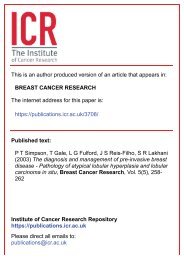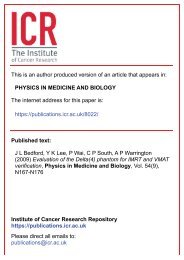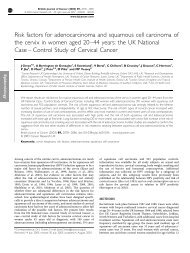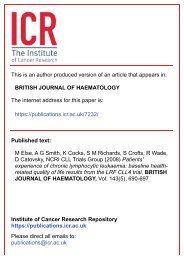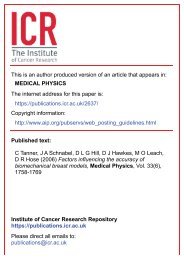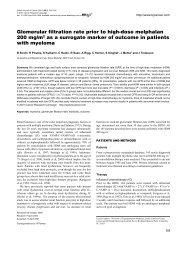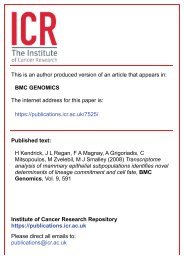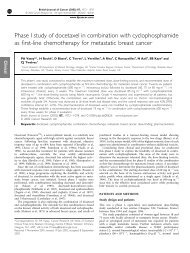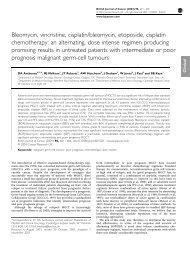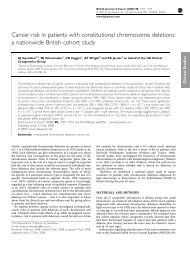Pattern of local recurrence after conservative surgery and ...
Pattern of local recurrence after conservative surgery and ...
Pattern of local recurrence after conservative surgery and ...
Create successful ePaper yourself
Turn your PDF publications into a flip-book with our unique Google optimized e-Paper software.
Sarcoma (2001) 5, 83–88ORIGINAL ARTICLE<strong>Pattern</strong> <strong>of</strong> <strong>local</strong> <strong>recurrence</strong> <strong>after</strong> <strong>conservative</strong> <strong>surgery</strong> <strong>and</strong> radiotherapyfor s<strong>of</strong>t tissue sarcomaSUSAN J. CLEATOR 1 , CHRIS COTTRILL 2 & CLIVE HARMER 11 Sarcoma Unit, Royal Marsden Hospital NHS Trust, London SW3 6JJ, <strong>and</strong> 2 St Bartholomew’s Hospital, London EC1A7BE, UKAbstractPurpose: Over the past three decades our centre has adopted a policy <strong>of</strong> <strong>conservative</strong> <strong>surgery</strong> followed by adjuvant radicaldoseradiotherapy for medium- <strong>and</strong> high-grade s<strong>of</strong>t tissue sarcomas. For all cases <strong>of</strong> <strong>local</strong> <strong>recurrence</strong> following this treatmentwe aimed to define the spatial relationship between sites <strong>of</strong> <strong>recurrence</strong> <strong>and</strong> the positions <strong>of</strong> the phase 1 <strong>and</strong> 2 radiotherapyvolumes.Patients: We identified 25 cases <strong>of</strong> <strong>local</strong> <strong>recurrence</strong> recorded on our s<strong>of</strong>t tissue sarcoma database between 1986 <strong>and</strong> 1999inclusive. We excluded patients with macroscopic residual disease following <strong>surgery</strong>. Most patients were treated with a phaseI volume corresponding to the entire muscle compartment (50 Gy in 25 fractions over 5 weeks) <strong>and</strong> a phase II volume correspondingto the tumour bed (10 Gy in five fractions). Six <strong>of</strong> the patients were treated according to a hyperfractionatedregimen.Methods: For each case we reviewed the diagnostic imaging, planning radiographs <strong>and</strong> prescription sheets. We auditedwhether treatment had been given according to protocol <strong>and</strong> defined whether <strong>recurrence</strong> had arisen in the phase 1 volume,phase 2 volume or ‘out <strong>of</strong> field’.Results: Four (16%) patients recurred within the phase I volume, 17 (68%) recurred within the phase II volume <strong>and</strong> four(16%) outside the irradiated volume including one marginal <strong>recurrence</strong>. In six patients there had been deviation from ourradiotherapy protocol (usually unavoidable) including all three true out <strong>of</strong> field <strong>recurrence</strong>s.Discussion: The majority <strong>of</strong> <strong>recurrence</strong>s occur in the phase 2 volume. Prospective multi-centre data collection <strong>and</strong>, ideally,a prospective r<strong>and</strong>omised trial are required to formulate an improved treatment policy with respect to radiotherapy margins<strong>and</strong> dose.Key words: sarcoma, post-operative radiotherapy, <strong>recurrence</strong>, <strong>conservative</strong> <strong>surgery</strong>IntroductionThe recommended treatment <strong>of</strong> resectable high-grades<strong>of</strong>t tissue sarcoma is <strong>conservative</strong>, organ-preserving<strong>surgery</strong> followed by adjuvant radical radiotherapy.Combined modality treatment <strong>of</strong> this nature canachieve 5-year <strong>local</strong> control rates <strong>of</strong> 85–90% 1–7 <strong>and</strong> 5-year overall survival rates in excess <strong>of</strong> 70%. 1–3,5,7,8 Interms <strong>of</strong> <strong>local</strong> control <strong>and</strong> survival this comparesfavourably with the results achieved by radical <strong>surgery</strong>or amputation. 5,9,10 In addition to a <strong>local</strong> failure rate<strong>of</strong> up to 20% at 5 years, <strong>local</strong> <strong>recurrence</strong>s later thanthis have been documented. 2 Approximately 60% <strong>of</strong><strong>recurrence</strong>s are salvageable with further <strong>surgery</strong> butthis may involve amputation. 2–4In delivering postoperative radiotherapy we aim toimprove functional outcome by reducing the extent<strong>of</strong> surgical resection required to achieve cure.However, radiotherapy morbidity can also impact onfunction <strong>and</strong> there is evidence that the risk <strong>of</strong>complications increases with both dose 7,8,11 <strong>and</strong> fieldsize. 11 Between sarcoma units practice variesconsiderably with respect to the size <strong>of</strong> radiationportal employed relative to the tumour bed; somecentres, including ours, irradiate the entire muscularcompartment whilst others utilise a much smallervolume, treating the tumour bed with a margin <strong>of</strong> afew centimetres only by means <strong>of</strong> brachytherapy. 12Over the last two decades our unit has adopted atreatment policy <strong>of</strong> <strong>conservative</strong> <strong>surgery</strong> <strong>and</strong> adjuvantradiotherapy for all high <strong>and</strong> medium-grade tumours.The majority <strong>of</strong> patients are treated in accordancewith a strict radiotherapy protocol. 13 Our sarcomadatabase was used to identify 25 cases <strong>of</strong> <strong>local</strong> <strong>recurrence</strong>dating back to 1986. Disease <strong>and</strong> treatmentdetails relating to each case were analysed to identifythe exact spatial relationship between site <strong>of</strong> <strong>recurrence</strong><strong>and</strong> the irradiated volume.Correspondence to: Dr Susan Cleator, Department <strong>of</strong> Radiotherapy, Royal Marsden Hospital, Fulham Rd., London SW3 6JJ, UK. Fax:+44-20-7808-2094; E-mail: suzy.cleator@virgin.net1357–714X print/1369–1643 online/01/020083–06 © 2001 Taylor & Francis LtdDOI: 10.1080/13577140120048584



